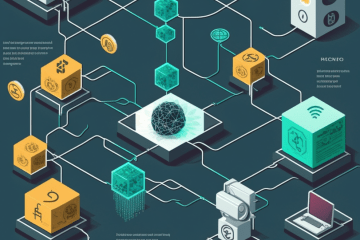Blockchain technology has taken the world by storm, revolutionizing the way we store and exchange value, data, and assets. The technology is creating a decentralized digital ecosystem that is transforming various industries, from finance and healthcare to supply chain management and cybersecurity. Blockchain is the underlying technology that powers cryptocurrencies like Bitcoin, Ethereum, and more. But its applications extend far beyond cryptocurrencies.
In this blog, we will delve into the basics of blockchain technology, explore its transformative potential, and examine its applications in different industries.
What is Blockchain Technology?
Blockchain technology is a decentralized, digital ledger that records transactions and information across a network of computers. Each block of information is cryptographically linked to the previous block, creating a chain of blocks, hence the name blockchain. The technology is decentralized, meaning there is no central authority that controls the network. Instead, the network is maintained by a distributed network of nodes that validate and verify transactions.

The key features of blockchain technology are its transparency, immutability, and security. Transactions recorded on the blockchain are transparent and can be viewed by anyone, making the technology highly auditable. The technology is also immutable, meaning that once a transaction is recorded on the blockchain, it cannot be altered or deleted. This makes it highly secure and resistant to fraud and hacking attempts.
Applications of Blockchain Technology
Blockchain technology has numerous applications in different industries. One of the most significant applications is in finance, where blockchain technology is powering cryptocurrencies and revolutionizing the way we store and exchange value. Cryptocurrencies like Bitcoin and Ethereum are decentralized, meaning they are not controlled by any central authority or government. This makes them highly secure and resistant to hacking attempts.
Blockchain technology is also being used in healthcare to store and exchange medical records securely. With the technology, patients can have more control over their medical records and grant permission for their data to be accessed by healthcare providers. This makes it easier for healthcare providers to access patients’ medical histories, making treatment more efficient and effective.
Another area where blockchain technology is being applied is in supply chain management. With blockchain technology, it is possible to track goods and products from the point of origin to the point of consumption. This increases transparency and makes it easier to verify the authenticity of goods and reduce counterfeiting.
Potential of Blockchain Technology
The potential of blockchain technology extends far beyond the applications mentioned above. One area where blockchain technology is showing immense potential is in decentralized finance (DeFi). DeFi is a financial system built on the blockchain that enables peer-to-peer transactions without the need for intermediaries. This makes financial transactions faster, cheaper, and more efficient.
Blockchain technology is also showing potential in digital identity. With the technology, it is possible to create a secure and decentralized digital identity that can be used to authenticate users and grant access to services.
Smart contracts are another area where blockchain technology is showing potential. Smart contracts are self-executing contracts with the terms of the agreement between buyer and seller being directly written into lines of code. This reduces the need for intermediaries, making transactions faster, cheaper, and more secure.
Challenges and Risks of Blockchain Technology
As with any emerging technology, there are challenges and risks associated with the use of blockchain technology. One of the biggest challenges is scalability. Currently, the blockchain can only handle a limited number of transactions per second, making it difficult to scale to meet the demands of global applications.
Interoperability is another challenge that needs to be addressed. Different blockchain networks operate in isolation, making it difficult to exchange data and assets between different networks. This limits the potential of the technology to transform various industries.
Regulation is also a challenge that needs to be addressed. Governments are struggling to create a regulatory framework that can keep up with the fast-paced development of blockchain technology. This has created uncertainty for businesses and investors, limiting the potential of the


